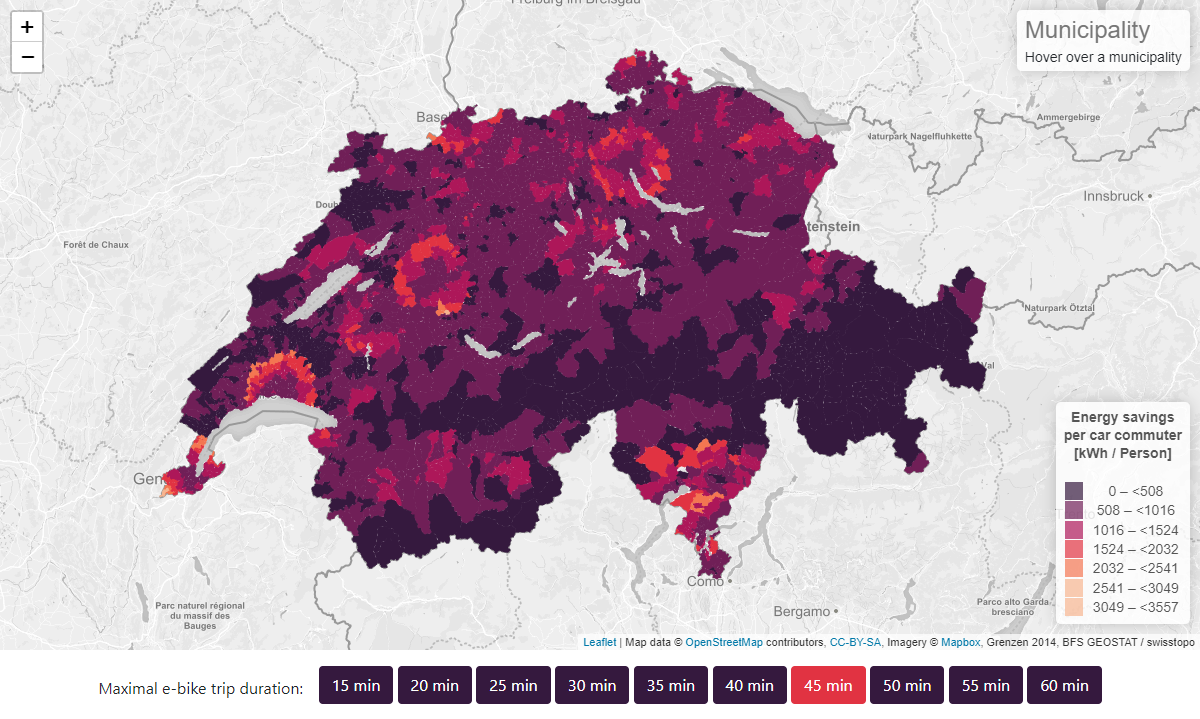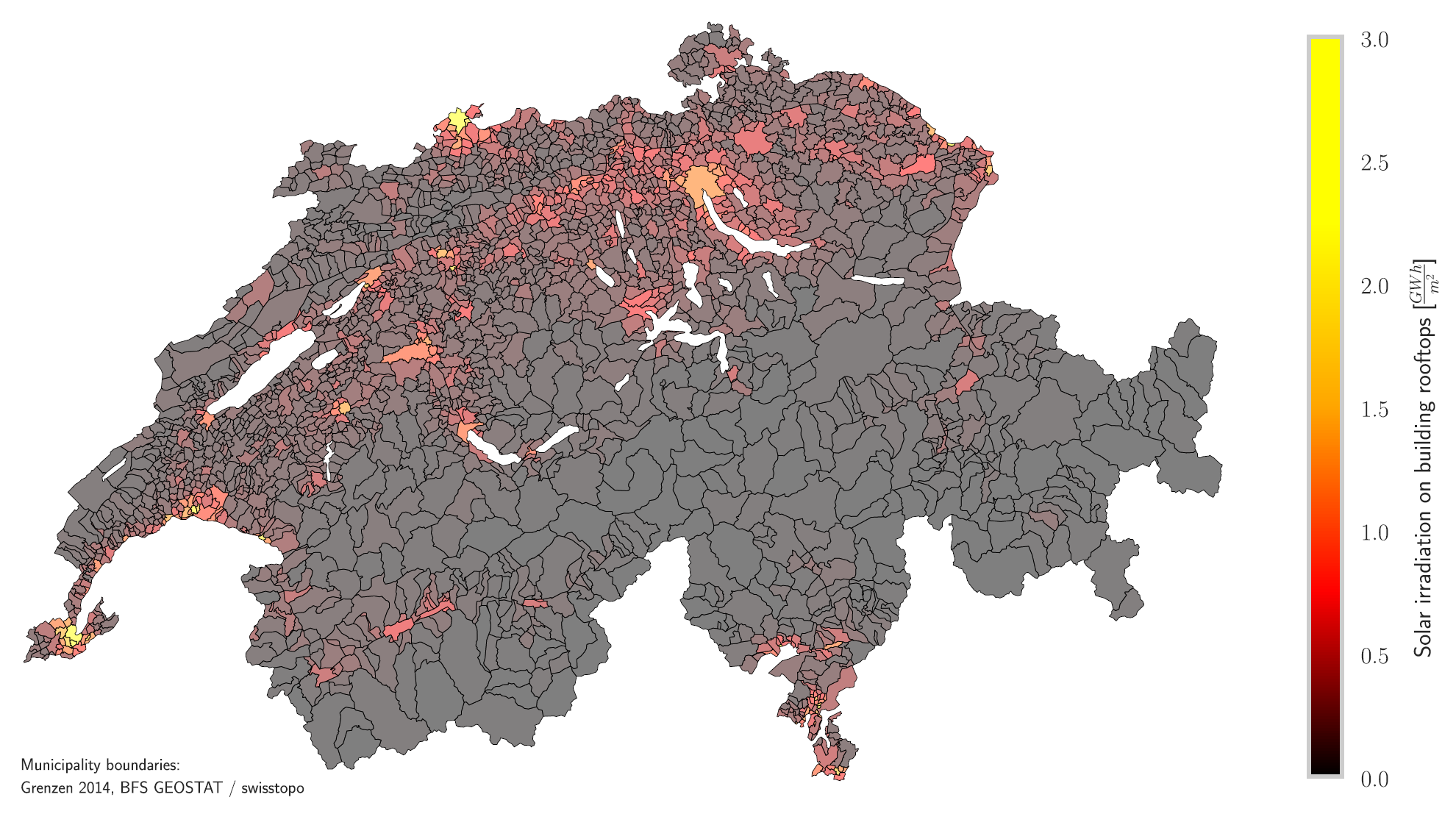Energy Saving Potential of a Wide Deployment of e-Bikes in Switzerland
17. September 2019With the Energy Strategy 2050, Switzerland committed to reduce greenhouse gas emissions by 43% until 2035. Currently, the transport sector is the only sector without a decrease in energy consumption. In our recent publication (also presented at Scientifica 2019), we analyzed the energy and greenhouse gas reduction potentials when e-bikes are used instead of internal combustion engine cars for commuting. Our analysis includes different scenarios for the minimal temperature, maximal precipitation as well as trip duration acceptable to take the e-bike. The results show that energy reductions between 10% and 17.5% are possible. If you are interested in the saving potentials in your municipality, please visit this website.

You can find the paper on Researchgate.
Could we Electrify Trucks in Switzerland?
12. August 2019In his semester project, Master student Keyuan Yin looked at the future of logistics in Switzerland. In particular, he analyzed how electric trucks might shape the future energy demand and distribution of Switzerland. Three types of BYD (a Chinese manufacturer) battery electric trucks with different loading and range capabilities were considered as potential replacements of registered internal combustion engine trucks. The method was based on truck journey data collected by the Swiss Federal Statistical Office, and our findings indicate that already nowadays between 71% and 74.5% of trucks could be replaced by battery electric trucks, which would result in a net reduction of 0.67 Mt of CO2 emissions. As many of the replaced trucks only cover small daily distances, we argue that larger battery packs than currently available in commercially offered trucks are a necessity.

You can find more information on the poster that we recently presented at the 6th SCCER Mobility Annual Conference.
Introducing the MIE Lab's Human Mobility Analysis Framework trackintel
01. May 2019
We are very excited to announce that we started development of an open source framework to process and analyze human mobility data, based on GPS recordings. In our research, we frequently stumbled upon the need to quickly perform various preprocessing and analysis tasks on GPS data. These include segmentation, transport mode detection, map matching, extraction of metrics for various transport modes (average daily distance, duration, etc.), staypoint detection, but also mobility prediction, generation of alternative transport routes, assessment and classification of behavior, context augmentation, and many more.
While our first efforts target the most basic preprocessing and analysis steps, we will continuously add results and algorithms from our most cutting-edge research on the processing of mobility data. You can find the library in the MIE Lab's GitHub repository.
Results from the GoEco! Study Available
08. November 2018The GoEco! project came to an end and the GoEco! and GoEco! Tracker apps, developed within it, are no longer available on the Android and iOS stores.

The study has shown that apps like GoEco! have the potential to help people travel more sustainably. In particular, people in the Southern part of Switzerland (Ticino), where the car is the most common mode of transport for many people, started traveling more ecologically sustainable on their systematic routes (e.g., commutes, visiting friends and/or family, shopping). In Zurich, people did not adapt their behavior, as many of them are already frequent users of public transport. Similarly, the transport modes for leisure activities did not change significantly. This is partly due to the fact that locations of leisure activities are often in remote places (or at least people do not immediately know any viable transport alternatives), that often you have to carry additional things that are required for the leisure activities, or simply due to the fact that it is more convenient to travel by car if you have a whole family to transport.
You can find an extensive treatment and explanations of all results in our three final publications:
- A Large Scale, App-Based Behaviour Change Experiment Persuading Sustainable Mobility Patterns: Methods, Results and Lessons Learnt
- Beyond Limitations of Current Behaviour Change Apps for Sustainable Mobility: Insights from a User-Centered Design and Evaluation Process
- From location tracking to personalized eco-feedback: A framework for geographic information collection, processing and visualization to promote sustainable mobility behaviors
Of course, like usual, you can find more publications related to GoEco! on the research page, as well as on the GoEco! website.
Using Locally Produced Photovoltaic Energy to Charge Electric Vehicles
06. September 2017As more and more countries announce their plans for banning combustion engines (e.g., [1, 2]), it becomes critical to find ecologically sustainable ways to power electric vehicles. While wind and water provide energy throughout the whole day, photovoltaic installations have production peaks around midday which need to captured either by smart appliances (such as washing machines) or by some form of energy storage, such as batteries or water reservoirs. A solution for both problems could be to use the car batteries to cap the solar production peaks - possibly even completely locally, i.e., without requiring transmission lines to transport energy over large distances.
Our paper Using Locally Produced Photovoltaic Energy to Charge Electric Vehicles [3] (to be published in Computer Science - Research and Development and presented at D-A-CH+ Energieinformatik 2017) discusses this potential of using solar energy to power electric cars of commuters in Switzerland. On the one hand, we compute the potentially available solar energy on rooftops in each municipality:

This is put in relation to the energy required by all work commuting travels, both within municipalities, as well as between different ones. The routes traveled are given as follows:

In a first scenario, we assume that people only charge their electric cars during the day at their workplace. We find that without shifting power from one municipality to another it is possible to cover up to 89% of the energy demand of commuter mobility. This also means that in larger cities (which have a high photovoltaic potential due to many rooftops), energy production peaks can be captured by electric cars, without the need to deploy additional batteries or storage capacity. The following figure shows the energy balance in July:

In a second scenario, where people only charge their cars at home (usually during the night), solar energy could cover 99.95% of the commuter energy demand. However, this requires installed storage capacity of around 9.32 GWh to shift the energy from day to night. Currently, 13.5 kWh batteries are targeted at homeowners, which means that around 690'000 households in Switzerland would need to be equipped with such a battery to let people charge their cars at home during the night.
The above presented analyses consider a full coverage of rooftops with solar panels, as well as a complete replacement of combustion engine cars with electric cars. This shift will not happen instantaneously, so the values should be taken solely as indications of potential future energy balances. It also needs to be noted that leisure travel and freight transport make up a substantial amount of mobility, which is not represented in above numbers. For more details, seasonal influence on solar energy production, and scenarios where people charge cars both at home and at work, please refer to the paper.
[1] https://www.theguardian.com/business/2017/jul/06/france-ban-petrol-diesel-cars-2040-emmanuel-macron-volvo
[2] http://www.independent.co.uk/environment/climate-change/norway-to-ban-the-sale-of-all-fossil-fuel-based-cars-by-2025-and-replace-with-electric-vehicles-a7065616.html
[3] https://www.research-collection.ethz.ch/handle/20.500.11850/173513
Introducing the dominikbucher.com Blog
08. August 2016After spending some time the last couple days to overhaul my website, I finally managed to include a super small blog as well. While very rudimentary for the moment (it basically just allows me to publish and edit posts using markdown), I will slowly but surely expand this to cover other needs that arise (comments, tags, nicer design, etc.).
This blog will mainly contain:
- Short articles which mostly serve myself as a memory helper for things I did, but might be of use to someone else as well (e.g., how to configure a certain library, or set up some software).
- Thought provoking paragraphs on ideas that come to my mind (you will have to take these with a grain of salt, they might be very rough).
- Longer articles covering topics I think are interesting, but are not large or interesting enough for a scientific publication.
- Summaries and explaining posts to scientific articles, mostly to make them approachable to a larger audience.
The stuff written in the blog is my own, so don't blame anyone else for it ;).
Along with the blog, I gave the site a bit of an overhaul. A big change is the street network graph on the main page. It is an extent of the streets of Zurich, and some relatively stupid agents going from A to B on it. Nothing fancy for the moment, but I might update this at some point, when I'll have time...

The underlying data comes from OpenStreetMap, and the whole visualization is done using sketch.js. If I manage to clean up the code, I might write some more about it here as well...
Until then, cheers!

